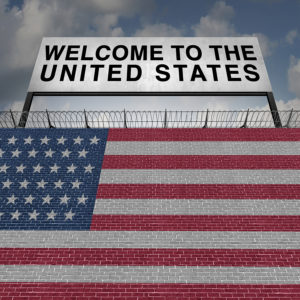While the White House and congressional Democrats engage in trench warfare over the definition of the word “wall,” America’s border security challenge goes unaddressed. We can strengthen our borders and reduce illegal immigration, if we focus on effective solutions to real problems.
We should be clear about one thing: It is reasonable to protect our border, and in some cases physical barriers will be the most cost-effective solution. In fact, over the last two decades with bipartisan support we have spent billions to build almost a thousand miles of barriers — including things that some people would describe as walls.
At the same time, we should be equally clear that a barrier is still just a barrier. It makes it more difficult to cross the border, but can never make it impossible. It may deter some from leaving their homes, but it will not affect the forces driving that emigration.
For many Central Americans the choice is between certain death if they remain at home and possible death if they emigrate. Faced with that choice, most of us would emigrate.
How might we more effectively use taxpayer dollars to solve these challenges?
The $5.7 billion would be better targeted at technology and personnel to enhance screenings of cargo at ports of entry, additional immigration judges, and foreign assistance in Central America.
The administration’s concerns about trafficking of illegal drugs are valid. The United States does have a significant opioid problem. According to the Centers for Disease Control, 70,237 drug overdose deaths occurred in the United States in 2017.
However, most drug smuggling takes place through ports of entry. Substances such as heroin, fentanyl and cocaine are disguised as cargo. Even marijuana smuggling, which avoids legal ports of entry because marijuana is difficult to conceal, was unaffected by construction of hundreds of miles of border barriers between 2003 and 2009, according to a Cato Institute report.
Simply put, focusing solely on a border wall will not reduce the number of illegal drugs entering the United States.
Instead, a part of the requested funds should be used to improve customs screening, enabling agents to intercept more illicit cargo. Improved inspections can be made more effective through better cooperation with Mexican law enforcement agencies. Not only is it a wiser investment of taxpayer dollars, it has a greater chance of deterring and discovering illegal drugs.
The caravans — groups of hundreds of asylum-seeking migrants who are journeying from Central America to the U.S. border — dominated headlines in 2018 and continue to do so. To say they are seeking asylum is an important distinction: It means they are not trying to sneak undetected into the United States. Rather, they want to apply for legal status as refugees.
From October to December, border patrol agents detained 60,000 migrants, many attempting to seek asylum, at U.S. ports of entry and in the vast stretches of border in between. But illegal border crossings remain at a two-decade low. In the 2000s, a much smaller force of agents arrested more than 100,000 migrants a month.
However, our ports of entry are still overwhelmed by Central American families fleeing gang violence and widespread lack of economic opportunity. Unlike the Mexican migrants of 30 years ago, many of the Central Americans are seeking asylum, and our immigration courts do not have the capacity to process their claims quickly. This is but one bottleneck creating a unique problem while families await adjudication: limitations on the detention of children.
Detaining and deporting these families only addresses a symptom rather than fixing the root cause of their recent migration. If we do not want to admit these asylum seekers — and under U.S. law people seeking economic opportunity generally do not qualify — we have to be realistic about working with the Central Americans to help them stabilize their countries and improve economic conditions.
Of course, the region’s problems must be solved by Central Americans themselves, and many of the reasons their economies don’t thrive have to do with badly designed policies. Nonetheless, U.S. assistance dollars are a way of dealing ourselves into the game, so that we can press those governments to begin addressing the reasons people flee.
We can help these countries so their people have the freedom and opportunity to stay home and raise their families in peace and prosperity. This is a proven approach and it is a better investment of American tax dollars than walls in the desert.
A nation has an obligation to defend its borders, and a wall is not inherently immoral. But there is not a national security crisis at our border. The problems we are experiencing are more complex and require a more complex solution that includes additional technology and personnel at ports of entry, additional immigration judges, and foreign assistance in Central America.
Let’s stop fighting over a sideshow and start working on the very real problems we face. We can solve them if we reach for the right solutions.

